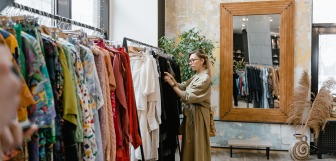Fashion Spending Rises in the UK as Socialising Returns
It would be an understatement to say that the extraordinary circumstances of the last couple of years have had a bit of an impact on how we live our lives. Many people have had to reorient themselves to living in a post-pandemic reality.
Businesses in the retail and hospitality industries have been particularly hard hit and many struggled to stay afloat. Businesses in England are struggling to retain good employees thanks to the “great resignation.” [1] But despite the difficulties that we as a society have been experiencing, it’s not all doom and gloom.
The happy news for clothing stores is that public spending on clothing is up from pre-pandemic levels as consumers embrace “revenge spending”. In this blog, we’ll examine this phenomenon and explain why it’s happening.
What is revenge spending?
Revenge spending, also sometimes referred to as revenge buying, refers to specific consumer behaviour where retailers see an uptick in the sale of non-essential goods and services after a negative economic event.
In more basic terms, revenge spending is what happens when consumers decide to start making up for lost time. In the initial stages of the pandemic, retailers understandably saw a drop in sales. Fashion has seen the strongest rebound as things return to normal.
What are consumers buying?
According to data from the British Retail Consortium (BRC), sales in June 2022 for almost all non-food items were down [2]. This includes usually strong sectors, such as toys, technology, and homeware.
The BRC has reported the exact opposite for the clothing market; this is where we see the clearest evidence for revenge spending. According to their data, clothing took two of the top three categories in fastest growth, with footwear at one and clothing at three.
In a study from data analytics and brand consultancy firm Kantar commissioned by The Guardian newspaper, it appeared that consumers were spending less on workwear (suits, shirts, and smart shoes) and more on flexible items like t-shirts and dresses. [3]
In addition to this increased spending on casual wear, retailers are seeing an increase in spending on sportswear. Kantar found that since 2019, there has been a rise of 3% in sportswear sales. This can also be seen in sports footwear where sales are up by a fifth over the same period.
Gain all the advantages of an EPOS system with detailed, flexible, downloadable reports, and so much more:
- Manage and update products quickly with easy-to-use software
- Expand your business into multiple channels and integrate with a variety of online platforms
- Manage multiple locations and salespoints with multi-site management
- Keep queues short with streamlined, modifiable sales processes
- Choose a setup that suits you with software and hardware options

What’s behind this rise?
Living in a post-pandemic world has had huge impacts on consumer behaviour and how retailers do business. The boost in fashion sales over the last year may be hard to parse for those outside of retail marketing. However, once we take in the bigger picture, we can get a good understanding of what’s going on in fashion retail.
There is a myriad of reasons for this boost in fashion sales but they all come back to the COVID-19 pandemic. As we’ve seen, revenge spending can be a very powerful force in the retail industry. With this in mind, it could be said that the pandemic was the biggest driver of this phenomenon since the aftermath of the 2008 financial crisis.
Some of the reasons for the rise in UK fashion spending include:
Escapism
It’s marketing 101 to say that consumers don’t like to be told no. For many, buying a new piece of clothing or footwear can be the highlight of their month and being kept inside by a virus that they couldn’t control was sure to raise a few hackles.
By spending the money they would have otherwise spent on workwear on more casual pieces, consumers can give themselves back the feeling of control over their choices that the pandemic took away.
A return to socialising
As lockdown restrictions were eased across the country, many relished the chance to return to socialising out and about with friends and family. After the country was effectively shut down for the best part of two years, it is safe to say that consumers wanted to refresh their wardrobes.
Retailers can also thank high streets opening back up to the public as a source of the fashion bump. Primark, one of the most popular high street brands in England, has seen a rapid return to form thanks to in-person shopping. Sales jumped 81% over the 12 weeks to 28 May and were 4% up on 2019 levels.
Inflation
An interesting aspect of the Kantar report mentioned above was that the volume of clothing items sold has actually decreased since 2019 while profits have stayed relatively stable. How could fashion retailers be seeing the rise we’ve been talking about here if they’re selling fewer clothes?
The simple answer to the question is inflation. For those not familiar with the term, inflation refers to the purchasing power of a country’s currency over time. This means that while consumers may be buying fewer pieces of clothing, they’re actually paying more for them than they were pre-pandemic.
Take advantage of the rise in fashion spending
If you’re a clothing retailer, you may be salivating at the thought of how much you could make as revenge spending continues. To make sure you’re ready for the rush, invest in an Epos Now Complete Solution which includes everything you need to start trading.
If you’re interested in finding out more about Epos Now, get in touch with our expert team below.



